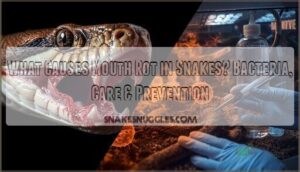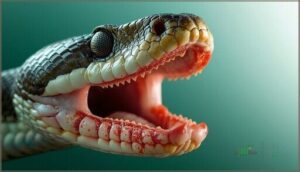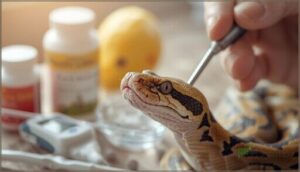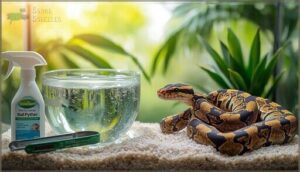This site is supported by our readers. We may earn a commission, at no cost to you, if you purchase through links.

Your snake’s swollen, discolored gums aren’t just unsightly—they signal infectious stomatitis, commonly known as mouth rot. This bacterial or fungal infection invades oral tissues through tiny wounds, transforming minor abrasions into ulcerated lesions within days. Left untreated, mouth rot progresses from localized inflammation to a life-threatening systemic infection, with mortality rates climbing sharply once bacteria spread beyond the oral cavity.
The culprits behind this condition aren’t mysterious pathogens lurking in exotic environments. They’re opportunistic bacteria already present in your snake’s enclosure, waiting for a weakened immune system or damaged tissue to gain entry. Understanding what causes mouth rot means examining both the infectious agents involved and the husbandry failures that create opportunities for disease.
Table Of Contents
- Key Takeaways
- What is Mouth Rot in Snakes?
- Bacterial and Fungal Causes of Mouth Rot
- Environmental and Husbandry Risk Factors
- Health and Physical Risk Factors
- Preventing Mouth Rot in Pet Snakes
- Frequently Asked Questions (FAQs)
- How does mouth rot start?
- What causes RI in ball pythons?
- How to treat snake mouth rot at home?
- What bacteria cause mouth rot?
- How long does mouth rot treatment take?
- Can mouth rot spread to other snakes?
- What are the treatment costs for mouth rot?
- Is mouth rot painful for snakes?
- Can mouth rot cause permanent jaw damage?
- Can mouth rot spread between snakes?
- Conclusion
Key Takeaways
- Mouth rot develops when opportunistic bacteria like Aeromonas hydrophila and Pseudomonas aeruginosa invade oral tissues through minor wounds, but the real culprit is poor husbandry—suboptimal temperatures, dirty water bowls, and stress suppress your snake’s immune system and create bacterial breeding grounds.
- Early treatment achieves over 90% recovery, but untreated infections escalate from localized inflammation to life-threatening systemic disease within days, making swift veterinary intervention the difference between a minor setback and fatal complications like pneumonia or bone necrosis.
- Prevention centers on maintaining proper enclosure conditions (75-95°F temperature gradients, 40-75% humidity), daily water changes, weekly disinfection, and feeding pre-killed prey to eliminate the trauma and stress that compromise your snake’s natural defenses.
- Antibiotic resistance complicates treatment significantly—39% of adult Pseudomonas strains resist multiple drugs, and 100% of Staphylococcus isolates resist ampicillin—making proper diagnosis and targeted therapy essential rather than relying on broad-spectrum antibiotics.
What is Mouth Rot in Snakes?
Mouth rot, medically known as infectious stomatitis, is a bacterial or fungal infection that affects the oral cavity and surrounding tissues of snakes. This condition develops when pathogens invade damaged or weakened oral tissue, leading to inflammation, tissue death, and potentially systemic infection if left untreated.
Understanding how this disease progresses, along with its severity and prognosis, helps you recognize warning signs early and seek appropriate veterinary care for your snake.
Definition and Medical Term
Snake mouth rot, clinically known as infectious stomatitis, describes bacterial or fungal infections affecting your snake’s oral tissues. Veterinarians use several specific terms to describe this condition:
- Ulcerative stomatitis – when tissue inflammation creates open sores
- Necrotic stomatitis – when oral tissues begin dying
- Infectious stomatitis – the general term for snake infections in the mouth
These oral infections cause tissue inflammation that can progress to necrotic changes without treatment. Often, poor husbandry practices can weaken the snake’s immune system, predisposing them to this condition.
How Mouth Rot Develops
Opportunistic bacteria invade your snake’s oral tissues when minor trauma—like cuts from prey or cage rubbing—creates entry points. Within days, bacterial invasion triggers tissue inflammation and ulceration. Without intervention, infection progresses to tissue necrosis, with yellow pus accumulating in the mouth.
Immune suppression from stress or poor husbandry accelerates this trauma onset, allowing mouth rot to advance from localized infection toward systemic complications. Snakes with a compromised immune system are also at an increased risk.
Severity and Prognosis
Clinical severity of snake mouth rot ranges from mild inflammation to life-threatening systemic infection. Early diagnosis yields an excellent prognosis—over 90% recovery with prompt veterinary attention and treatment success through antibiotics and supportive care.
Snake mouth rot ranges from mild inflammation to life-threatening infection, but early treatment achieves over 90% recovery
Untreated cases commonly progress to fatal complications like pneumonia or bone necrosis. Infectious stomatitis diagnosis and treatment timing directly determine long-term outcomes, making swift action essential for your snake’s survival.
Bacterial and Fungal Causes of Mouth Rot
Mouth rot doesn’t just happen on its own—it’s triggered by specific bacteria and fungi that invade your snake’s oral tissues. These pathogens take advantage of weakened defenses, turning minor irritation into a full-blown infection.
Let’s look at the most common microbial culprits behind this condition.
Aeromonas Hydrophila
Aeromonas hydrophila stands out as one of the most common bacteria behind snake mouth rot, thriving in water bowls and damp substrates. This bacterium poses zoonotic potential, meaning it can infect you too. Here’s what makes it particularly problematic:
- It produces virulence factors like hemolysins that rapidly destroy tissue
- Environmental reservoirs in your snake’s enclosure enable persistent infection
- Antibiotic resistance complicates treatment, especially to common beta-lactam drugs
Immune suppression from stress or poor husbandry opens the door for this infection in reptiles.
Pseudomonas Aeruginosa
Pseudomonas aeruginosa is a bacterium that causes caseous stomatitis, a condition characterized by aggressive tissue destruction. It is prevalent in captive snake populations, affecting 58.4% of adults and 71.7% of juveniles. This infection thrives in contaminated water bowls and spreads rapidly through unclean enclosures.
The bacterium poses significant risks, as outlined in the following table:
| Risk Factor | Impact on Your Snake |
|---|---|
| MDR Prevalence | 39% of adult strains resist multiple antibiotics |
| Seasonal Variation | Autumn brings 14.6% infection rates in wild populations |
| Husbandry Links | Home-raised prey greatly increases MDR bacteria carriage |
The zoonotic potential and conservation implications of this bacterium make proper enclosure sanitation essential for preventing the deadly mouth rot infection it causes.
Staphylococcus Species
Staphylococcus stands out as the most common Gram-positive bacterium in snake mouth rot cases, with isolation rates reaching 34.5% in some populations.
Your snake’s infection likely involves Staphylococcus sciuri or S. xylosus acting as opportunistic pathogens following trauma or stress.
These bacteria show alarming antibiotic resistance, with 100% resistant to ampicillin and 84.3% exhibiting multidrug resistance, making proper diagnosis and targeted treatment essential for your snake’s health.
Gram-Negative Bacteria (E. Coli, Proteus, Salmonella)
Gram-negative bacteria dominate mouth rot infections, with Escherichia coli, Proteus, and Salmonella frequently appearing together in mixed infections. E. coli resistance complicates treatment, while Proteus virulence destroys tissue through enzyme production. Salmonella zoonosis poses risks to you and your family.
Over 80% of stomatitis cases involve multiple bacteria simultaneously, and antibiotic overuse has made these infections harder to treat effectively.
Fungal Infections
While bacteria get most of the blame, fungal infections add a dangerous twist to mouth rot. Ophidiomyces ophiodiicola causes snake fungal disease with a 40% SFD mortality rate in infected reptiles.
You’ll notice ulcerations and swelling around your snake’s mouth, requiring antifungal therapy and sometimes surgical removal of dead tissue. Fungal diagnosis combines clinical signs with lab testing to catch stomatitis early.
Environmental and Husbandry Risk Factors
While bacteria cause the infection itself, your snake’s environment often sets the stage for mouth rot to develop. Poor husbandry doesn’t directly introduce pathogens, but it weakens your snake’s defenses and creates conditions where harmful bacteria thrive.
Let’s look at the specific environmental factors that increase your snake’s risk of developing this painful condition.
Poor Enclosure Hygiene
Your snake’s enclosure can become a breeding ground for dangerous bacteria if you don’t keep it clean. Dirty enclosures and water contamination are primary causes of snake mouth rot, or stomatitis, because bacteria like Aeromonas and Pseudomonas thrive in filth.
Biofilm formation in water bowls and substrate bacteria increase infection risk. Following strict sanitation protocols protects your snake’s health and prevents reptile care disasters.
Improper Temperature and Humidity
Think of your snake’s enclosure as a life-support system—temperature and humidity aren’t just settings, they’re immune boosters. Suboptimal thermal gradients weaken your snake’s defenses, letting mouth rot bacteria multiply.
You’ll need species-specific humidity levels (usually 50-80%) and proper ventilation to maintain snake health. Use digital monitoring tools to track both parameters across the enclosure, preventing the environmental stress that compromises reptile care and triggers infectious stomatitis.
Contaminated Water Bowls
Your snake’s water bowl isn’t just for drinking—it’s a potential pathogen reservoir. Waterborne bacteria like Aeromonas and Pseudomonas thrive in stagnant conditions, forming slimy biofilms that resist simple rinsing.
Biofilm buildup accounts for up to 80% of water-related infections, creating hygiene impacts that directly compromise snake health and reptile care.
Change water daily and scrub mechanically weekly to prevent these environmental conditions from triggering mouth rot through water contamination.
Inadequate Substrate Choices
Your floor choice matters more than you might think. Corn cob and walnut shells create trauma risk through mouth abrasions, while moisture-retentive substrates harbor bacterial growth from Aeromonas and Pseudomonas. Dusty materials pose respiratory risks that indirectly weaken oral immunity.
Poor humidity impact from unsuitable bedding dries mucosal barriers, and hygiene challenges from porous substrates make sanitation nearly impossible—perfect conditions for stomatitis to flourish.
Stress From Overcrowding or Lack of Hiding Spots
Overcrowding stress doesn’t just make your snake uncomfortable—it suppresses immune function by up to 40%, making mouth rot 2.5 times more common. Without adequate hiding spots, you’ll see chronic stress behaviors that directly damage oral health:
- Repetitive snout rubbing against cage surfaces
- Elevated stress hormones weakening immune defenses
- Increased competition leading to mouth injuries
- Persistent escape attempts causing facial trauma
- Secondary infections from compromised immunity
These stressors reduce lymphocyte counts by 30%, creating perfect conditions for stomatitis to take hold.
Health and Physical Risk Factors
Even when you maintain a spotless enclosure, your snake’s own health can open the door to mouth rot. A compromised immune system, nutritional gaps, or physical injuries create vulnerabilities that bacteria exploit quickly.
Let’s look at the internal and physical factors that put your snake at risk.
Mouth Trauma and Injuries
When your snake rubs against cage bars or wrestles with prey, even minor damage can spiral into stomatitis. Prey bite wounds, force-feeding injuries, and abrasive substrates create mucosal perforations—open doors for bacteria.
Cage bar trauma from escape attempts is surprisingly common, affecting over half of pet snakes. These injuries don’t heal like ours do; they invite infection, turning small wounds into full-blown mouth rot with alarming symptoms.
Compromised Immune System
When stress immunosuppression takes hold, your snake’s defenses crumble, allowing normal mouth bacteria to spiral into stomatitis. Viral coinfections, systemic diseases, and nutritional deficiencies weaken immune surveillance, turning manageable infections into severe reptile diseases.
The prognosis impact is significant—immunocompromised snakes face higher complication rates from compromised immune system function, making infection prevention critical rather than optional.
Poor Nutrition and Vitamin Deficiencies
When diet quality falls short, your snake’s oral tissues pay the price—vitamin A deficiency erodes mucous membranes, calcium imbalance weakens immune defenses, and nutritional stress opens the door to snake mouth rot.
Hydration impact matters too, as dry diets crack oral linings, inviting bacterial invasion.
Appetite loss often signals these deficiencies before stomatitis takes hold.
Parasites and Coexisting Diseases
Beyond bacteria alone, oral parasites like Kalicephalus nematodes and mites directly trigger immune suppression, paving the way for secondary infections and severe stomatitis.
Systemic illnesses—respiratory disease, viral infections, inclusion body disease—compound your snake’s vulnerability, making disease diagnosis critical.
Effective treatment demands integrated care:
- Target parasites with deworming protocols
- Address coexisting infectious diseases
- Restore immune function through supportive therapy
Preventing Mouth Rot in Pet Snakes
Prevention is the best medicine for mouth rot, and most cases can be avoided with proper husbandry practices. You have more control over your snake’s health than you might think.
Let’s look at the specific steps you can take to keep your snake’s mouth healthy and infection-free.
Maintaining Proper Enclosure Conditions
Your snake’s enclosure isn’t just a home—it’s the first line of defense against mouth rot. Maintaining proper temperature gradients between 75°F and 95°F aids immune function, while humidity levels around 40%-75% prevent mucosal breakdown.
Water quality matters; treat tap water with reptile-safe conditioners and change bowls daily. Choose substrates like cypress mulch to avoid mouth injuries, and provide adequate hiding spots to minimize stress factors that compromise reptile health.
Regular Cage Cleaning and Sanitation
You can’t eliminate pathogens without a rigorous cleaning schedule. Daily spot cleaning removes feces and uneaten food, while weekly disinfection with reptile-safe products combats bacterial buildup. Monthly deep cleaning with 10% bleach solutions targets lingering microbes.
Up to 70% of reptiles carry Salmonella, making proper waste management and disinfection methods essential to prevent snake mouth rot and other health risks from poor sanitation.
Feeding Pre-Killed Prey
Live prey can injure your snake—and that’s how bacteria enter. Feeding pre-killed prey eliminates defensive bites and scratches that create openings for mouth rot. Pre-killed offerings maintain full nutritional value while reducing trauma risk, supporting better welfare and immune defense.
- Eliminates rodent bites and deep wounds requiring surgery
- Reduces bacterial contamination from prey-inflicted injuries
- Maintains equivalent nutrition without live prey stress
- Prevents Aeromonas and Pseudomonas colonization through wounds
- Forms cornerstone of veterinary-recommended feeding protocols
Providing Balanced Nutrition
Proper nutrition strengthens your snake’s immune defenses against mouth rot. Balanced reptile nutrition aids tissue repair and infection resistance, making it foundational to snake care and preventive husbandry.
You’ll need to match prey type and frequency to species needs, ensuring adequate calcium balance through supplementation when necessary. Dietary variety prevents vitamin deficiencies that compromise oral tissues—prepare prey correctly to preserve thiamine and other nutrients.
Scheduling Regular Veterinary Checkups
Beyond nutrition, preventive reptile care and maintenance requires professional veterinary attention for early detection of subclinical infections. Vet expertise in reptile health and wellness provides owner education on husbandry corrections, making exam frequency a cornerstone of veterinary medicine for reptiles.
Schedule wellness exams at least annually for healthy adults, though twice-yearly visits offer cost benefits by catching problems before they escalate.
Frequently Asked Questions (FAQs)
How does mouth rot start?
Snake mouth rot, or infectious stomatitis, starts when opportunistic bacteria invade through small cuts or abrasions in oral tissues, especially when your snake’s immune system is weakened by stress or poor husbandry factors.
What causes RI in ball pythons?
Respiratory infections in ball pythons aren’t solely bacterial—viral infections like nidoviruses and serpentoviruses strike hard.
Bacterial pathogens, improper temperature gradients, low humidity levels, and immune compromise create the perfect storm for RI development.
How to treat snake mouth rot at home?
Home cleaning with dilute iodine or chlorhexidine can help mild mouth rot cases, but moderate to severe stomatitis requires veterinary antibiotics, pain management, and supportive care to prevent complications and guarantee recovery.
What bacteria cause mouth rot?
Aeromonas hydrophila and Pseudomonas aeruginosa dominate mouth rot infections, comprising 30–40% of bacterial isolates. Staphylococcus species, Gram-negative bacteria like E. coli and Proteus, and occasionally fungal infections also contribute to stomatitis.
How long does mouth rot treatment take?
Most cases of mouth rot (stomatitis) take two to four weeks to heal with proper antibiotics and supportive care, though severe infections may require up to three months of treatment and recovery.
Can mouth rot spread to other snakes?
Unfortunately, yes—mouth rot can spread between snakes. Transmission vectors like shared water bowls, feeding tools, and mites encourage contagion. Strong quarantine protocols and proper hygiene reduce stomatitis outbreaks in your collection considerably.
What are the treatment costs for mouth rot?
Your veterinary exam fee will start around $65 to $85, with basic antibiotic costs adding $50 to $200.
Surgical intervention for severe stomatitis can push total expenses toward $1,000, greatly affecting exotic pet care management budgets.
Is mouth rot painful for snakes?
Yes, mouth rot causes significant pain for snakes. Inflammation, swelling, and open sores create discomfort that leads to behavioral changes like refusing food, lethargy, and open-mouth breathing, requiring prompt veterinary treatment.
Can mouth rot cause permanent jaw damage?
Yes, severe mouth rot can cause permanent jaw damage. When infection spreads to the bone, it triggers osteomyelitis, leading to jaw misalignment, chronic infection, feeding impairment, and structural deformities that may require surgical intervention.
Can mouth rot spread between snakes?
Absolutely—mouth rot can spread between snakes through shared water bowls, feeding tools, and contaminated surfaces where bacteria like Aeromonas and Pseudomonas thrive, making quarantine protocols essential when infectious stomatitis strikes your collection.
Conclusion
Your snake’s oral health doesn’t deteriorate overnight—it unravels when husbandry gaps meet opportunistic pathogens. Understanding what causes mouth rot in snakes equips you to recognize the chain of failures before infection takes hold.
Clean enclosures, proper temperatures, and stress-free environments aren’t suggestions—they’re your primary defense against bacterial invasion. The bacteria already exist in your snake’s world. Your vigilance determines whether they remain harmless inhabitants or become life-threatening adversaries.
- https://pmc.ncbi.nlm.nih.gov/articles/PMC10891919/
- https://wvj.science-line.com/attachments/article/78/WVJ%2013(3),%20409-419,%20September%2025,%202023.pdf
- https://www.facebook.com/groups/967708664967231/posts/1309439494127478/
- https://www.thebhs.org/publications/the-herpetological-bulletin/issue-number-52-summer-1995/2585-hb052-08/file
- http://www.midogtest.com/blog/stomatitis-diagnosing-mouth-infections-in-reptiles/













